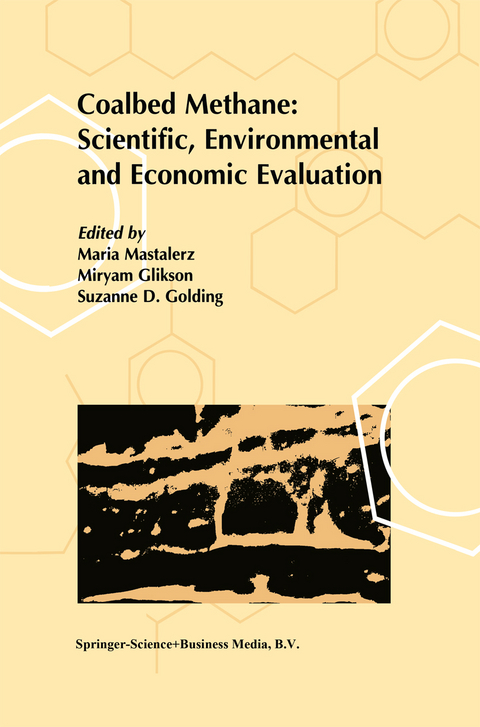
Coalbed Methane: Scientific, Environmental and Economic Evaluation
Springer (Verlag)
978-0-7923-5698-1 (ISBN)
1. Coal seam gas in Queensland from there to where?.- 2. Developing a new coal seam gas regime for Queensland.- 3. The Fairview coal seam gasfield, Comet Ridge, Queensland, Australia.- 4. Cost benefit analysis of coalbed methane recovery activities in Australia and New Zealand — Implications for commercial projects and government policy.- 5. The use of Monte Carlo analysis to evaluate prospective coalbed methane properties.- 1. Defining coalbed methane exploration fairways: An example from the Piceance Basin, Rocky Mountain Foreland, Western United States.- 2. Improving coal gas recovery with microbially enhanced coalbed methane.- 3. Coalbed methane exploration in structurally complex terrain: A balance between tectonics and hydrogeology.- 4. Coalbed methane exploration results of the Liulin Permit in China.- 5. Residual gas content of coal in the light of observations from the Upper Silesian Coal Basin, Poland.- 1. Coal composition and mode of maturation, a determining factor in the quantifying hydrocarbon species generated.- 2. The relationship between gas in coal seams and artificial coalification gas under hydrothermal pressure systems.- 3. Coalbed gas content and gas undersaturation.- 4. Higher hydrocarbon gases in southern Sydney Basin coals.- 5. Source and timing of coal seam gas generation in Bowen Basin coals.- 6. The development of an understanding of the origins of the Sydney and Bowen Basin gases.- 7. Mineral-catalyzed formation of natural gas during coal maturation.- 1. The role of in-situ stress in coalbed methane exploration.- 2. Mechanical and thermal control of cleating and shearing in coal: Examples from the Alabama coalbed methane fields, USA.- 3. The microstructure of pore space in coals in different rank.- 4. Coalbed characteristics of the MistMountain Formation, Southern Canadian Cordillera: Effect of shearing and oxidation.- 5. Decrease in desorption intensity of coalbed methane due to hydraulic fracturing.- 1. Coal seam gas emissions from Ostrava-Karvina collieries in the Czech Republic during mining and after mines closure.- 2. Countermeasures and researches for prevention of methane emission into the atmosphere in a Japanese coal mine.- 1. Modeling the hydrothermal generation of coals and coal seam gas.- 2. Simulating the conductive and hydrothermal maturation of coal and coal seam gas in the Bowen Basin, Australia.- 3. Modelling of petroleum formation associated with heat transfer due to hydrodynamic processes.- 1. Floral influences on the petroleum source potential of New Zealand coals.- 2. The influence of depositional and maturation factors on the three-dimensional distribution of coal rank indicators and hydrocarbon source potential in the Gunnedah Basin, New South Wales.- 3. The physics and efficiency of petroleum expulsion from coal.- 4. Jurassic coals and carbonaceous mudstones: the oil source of the Junggar and Turpan-Hami Basins, China.- 1. Examples of the methane exchange between litho- and atmosphere: The coal bearing Ruhr Basin, Germany.- 2. Desorption as a criterion for the estimation of methane content in a coal seam.- 3. Grading of reserves and resources of coalbed gas in China.- 4. Anhydride theory: A new theory of petroleum and coal generation.- 5. Looking back on development history of coalbed methane in China.- 6. The study of the influence of pressure on coalbed permeability.
| Erscheint lt. Verlag | 31.7.1999 |
|---|---|
| Zusatzinfo | IX, 592 p. |
| Verlagsort | Dordrecht |
| Sprache | englisch |
| Maße | 155 x 235 mm |
| Themenwelt | Naturwissenschaften ► Geowissenschaften ► Geologie |
| Naturwissenschaften ► Geowissenschaften ► Geophysik | |
| Naturwissenschaften ► Geowissenschaften ► Mineralogie / Paläontologie | |
| Technik ► Elektrotechnik / Energietechnik | |
| ISBN-10 | 0-7923-5698-5 / 0792356985 |
| ISBN-13 | 978-0-7923-5698-1 / 9780792356981 |
| Zustand | Neuware |
| Haben Sie eine Frage zum Produkt? |
aus dem Bereich


